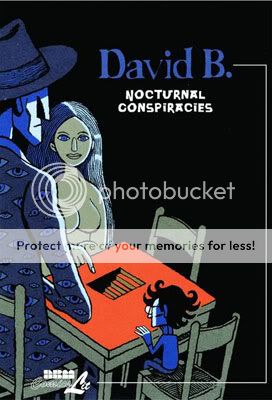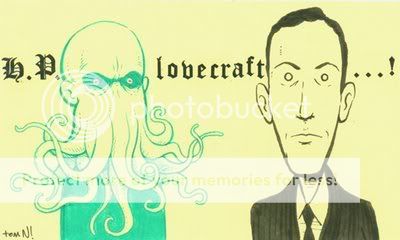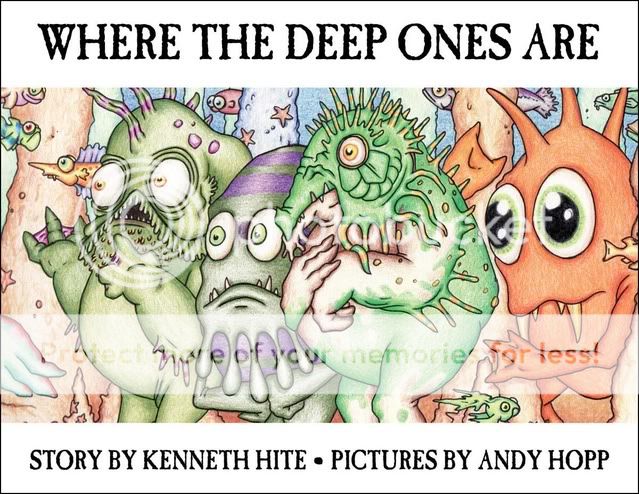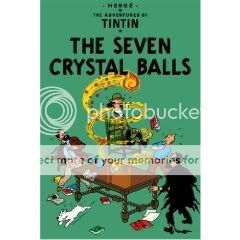Archive for December 8, 2008
Comics Time: Kramers Ergot 6
December 8, 2008Kramers Ergot 6
Sammy Harkham, editor
Alvin Buenaventura, assistant editor
Carlos Gonzales, Shary Boyle, Matthew Thurber, Jason T. Miles, Andrew J. Wright, Sammy Harkham, Fabio Viscogliosi, C.F., Dan Zettwoch, Mark Smeets, Marc Bell, Bald Eagles, Chris C. Cilla, Martin Cendreda, Paper Rad, Jerry Moriarty, Gary Panter, Suihô Tagawa, Vanessa Davis, Souther Salazar, James McShane, Shary Boyle, Jeff Ladouceur, Ron Regé Jr., Elvis Studio (Helge Reumann & Xavier Robel), Tom Gauld, John Porcellino, writers/artists
Chris Ware, Tim Hensley, Paul Karasik, contributors
Buenaventura Press/Avodah Books, 2006
336 pages
$34.95
Can I just say how much I love how this volume of Sammy Harkham’s landmark anthology series opens? Credits pages in big, no-nonsense, all-caps letters alternate with splash page pin-ups and blown-up panels from the strips to come. It’s like the book has an opening credit sequence. I coincidentally paged through it at the same time as listening to “Speed of Life,” the opening track on David Bowie’s album Low, and it was as delightful a comics-reading experience as I’ve had all year.
That said, this may be the least immediately impactful post-volume-four Kramers. In some ways that’s to be expected: The previous volumes, particularly 4, were so groundbreaking that at a certain point you kind of just have to stand there and say “wow, we’re standing on the ground we broke a while ago, how about that?” As a matter of fact, I think this is the farthest-out volume, least “alt,” most “art/underground” collection of the three–there’s a degree to which it takes for granted that you’re willing to slug it out there on the borderland between comics and fine art and tugs you deep into the realm of the non-narrative and non sequitur.
For the most part, that’s a fine decision. There’s rough stuff to ponder from Bald Eagles, whose self-pitying, society excoriating autobio strip is transformed into something of a sci-fi fantasia by art so maniacally detailed it makes Geof Darrow look like John Porcellino, and from Chris Cilla, who serves up a sordid, coprophilia-tinged story of undercover cops gone very very bad. There’s stunning color work to be found in the rainbow psychedelia of Shary Boyle’s series of disturbingly sexualized 18th-century illustration riffs, in the green-on-pink shimmerings of Matthew Thurber’s goofball saga of a high school overtaken by a Mayan human-sacrifice cult, and in the lush pastels of World War II-era manga-ka Suihô Tagawa’s deceptively adorable funny-animal war propaganda. There’s the de rigeur contribution from the reliably hilarious Paper Rad, a literal interpretation of “Kramer’s Ergot” that made this Seinfeld fan laugh out loud. Competing takes on minimalism–C.F.’s explosively dynamic sci-fantasy and John Porcellino’s suburban haiku–bookend the collection. This is all exciting work, bursting with visual vitality and a certain distaste for the rules. It’s mostly loud and it’ll get you funny looks when you read it on the train (trust me), but it’s also very intelligent, rarely if ever shock for shock’s sake.
However, I do feel like there’s a higher quotient of work here that doesn’t quite, uh, work. I’ve seen enough of the oft-anthologized donkey strips of Fabio Viscogliosi and Fervler & Razzle strips of Souther Salazar to last me for quite some time. Bald Eagles and Jason T. Miles aside, most of the autobio work here–from James McShane, Vanessa Davis, and Ron Regé Jr.–works any better here than it does in the other anthologies you might have seen it in lately. Marc Bell’s stream-of-consciousness illustration/text combos just make me wish he was making more of his hysterically funny, rewardingly weird comic strips instead. I think the formal strength of Gary Panter’s Dal Tokyo strips reprinted here is diluted somewhat by being surrounded by so much similar material, so much illogic’n’markmaking. On the flipside, the more straightforward strips–Tom Gauld’s latest “two lonely coworkers in a weird environment” strip, Harkham’s tale of discontent in the shtetl, an emo little thing from Martin Cendreda, another story of mild hijinks in a midwestern church that occasionally uses diagrams from Dan Zettwoch–feel drowned out by the visual cacophony of your Bells and Elvis Studios and the monumental fine-art splash pages of your Boyles and Jerry Moriartys.
But I tend to be quite forgiving to anthologies that serve up a selection of inconsistent but thrilling-at-its-best work, and in that sense Kramers Ergot 6 is no exception. Indeed, the entire Kramers project seems to me to be one of juxtaposition, a when-worlds-collide affair. Not all those worlds are going to be equally interesting, but that’s fine when the ones that are are so rich and rewarding of your comics-thinking time and attention.
Carnival of souls
December 5, 2008* Is it just me, or does the new, numerically enhanced trailer for the Friday the 13th remake (via Jason Adams) deliberately evoke this YouTube montage of every killing from the entire series?
* A collection of David B.’s dream comics? Where did this come from?
* Another thing about the end of Secret Invasion: So now Iron Man, title character of the hugely popular and effervescent film starring Robert Downey Jr., is not just a privacy-invading, gulag-running tyrant, but an incompetent one to boot, who is now staggering out of office in ignominy? That’s one way to play it, I guess. I’m not one to assert real-world allegories, but if you had to pick one real-world political figure with that basic career trajectory…let’s just say it’s not a person with whom I’d align the lead character in Marvel Studios’ main movie franchise.
* That being said, whatever problems I may have with the multi-year Civil War/Initiative/World War Hulk/Secret Invasion/Dark Reign uber-event as a story or as a vehicle for likable characters whose core concepts remain intact, I’m impressed as hell by it as an editorial/organizational/marketing mechanism. If you’re the kind of person who’s interested in the status quo of a shared corporate superhero universe in and of itself, I’d imagine it’s rather exciting to see all the ducks in a row on such a consistent basis.
* Hey, look, a new Doves album is on the way. I like this band a great deal. (Via Pfork.)
* Apparently I also like this band:
* Now here’s something that College Sean T. Collins would have paid money to see: A French prankster played Mario Kart in real traffic. This is the result. Just wait till you see the banana peels. (Via Topless Robot.)
* Look at the cover for Antony & the Johnson’s upcoming album The Crying Light. (Via Ryan Catbird.)
Comics Time: My Brain Is Hanging Upside Down
December 5, 2008My Brain Is Hanging Upside Down
David Heatley, writer/artist
Pantheon, September 2008
128 pages, hardcover
$24.95
The prospect of reviewing these intensely autobiographical comics by David Heatley is a daunting one because there seems to be no way to do so without reviewing David Heatley. Oddly, I’ve never really felt that way about his work before when I’ve encountered it. I thought his surreal “Overpeck” serial in MOME was powerful–as good as his dream comics might have been had he not labeled them “dream comics” and thus neutered their disquieting illogic. I’m also on the record as a great admirer of his “Sex History” strip as it appeared in Kramers Ergot 5 (the 48-panel grids were a brilliant way to convey such an overwhelming amount of uncomfortable information), and a defender of the “Portrait of My Mom” and “Portrait of My Dad” strips that appeared in Ivan Brunetti’s second Anthology of Graphic Fiction (they displayed Heatley’s underappreciated sense of humor and comedic build-up within each sub-strip). In none of these cases did I feel like I was evaluating Heatley as a person.
But My Brain put me in that uncomfortable position, perhaps–almost certainly, in fact–because my reaction to it was so viscerally negative. There are plenty of comics I’ve read that left me thinking “that should have been done differently”; this is the first I’ve read in a long time that made me think “this shouldn’t have been done at all” (and wasn’t written by Jeph Loeb). The primary culprit? “Race History,” a black-and-white (no pun intended) companion piece to “Sex History,” detailing Heatley’s relationships, however slight, with various black people he’s known. I’m trying to think of how to put this…there’s probably a way to take this idea and not make it just as dehumanizing and racist as it seems it would be, just as dehumanizing and racist as the behavior and mentality one assumes it’s designed to expose and excoriate, but boy howdy did Heatley not find that way! There’s something almost literally nauseating in this interminable onslaught of alternating bigotry and white liberal guilt. The point where my disgust for the strip became insurmountable was a scene where young David is sleeping over at a friend’s house, and the kid’s mother helps take care of David’s stomachache. “Try laying on yo belly. It should settle yo stomach down,” she says, in dialect reminiscent of late-’70s Marvel Comics street toughs, before David thinks “I forgot she’s a doctor.” And blam! It struck me how disgraceful it is to take this human being, who has a family, who worked the crazy hours and racked up the crazy student loans and god knows what else that all doctors do, reduced to a “blackcent”-spouting cameo in some guy’s ungodly long (seriously, at one point I closed the book and saw how many more black-trimmed pages of the strip I had left and my draw literally dropped) narcissistic display of how he’s spent his entire life looking at black people as being black before people.
I think the grossest thing about the strip, the part that prevents me from saying “well, he’s just cataloguing his own faults, he’s aware of how awful this is” is that even when his relationships with black people are healthy, mutually enjoyable ones, Heatley still seems to view them as trophies to prove his enlightenment. Every positive interaction with a stranger, every move to a black neighborhood that goes well, every friendship, every professor who helped him–it’s all the same as when he joined the Free Mumia movement, or the truly insufferable album (and sometimes movie/tv) reviews peppered throughout the strip where he proves how able he is to appreciate African-American culture. His review of the series The Wire has got to be the ne plus ultra of the genre:
One of the greatest works of art I’ve experienced in any medium. It unfolds with the kind of masterful pacing, sense of truth, reality, and tragic inevitability usually found in Tolstoy or Dostoevsky. It’s certainly the only TV show to alter my race conscious. I notice certain young black men who would have been invisible to me before, hidden behind the screen of my own ignorance and fear. I’d like to think I know something of their stories now. Awareness and compassion by themselves don’t change the world, but they’re a start. Speaking of which, did you know it’s Barack Obama’s favorite show, too?
This right next to a strip where he reacts to some jerky lady on the subway smacking him with her purse by coming home and beating a chair with his umbrella while shouting “YOU FUCKING NIGGER BITCH!” This incident just happened, too!
What I’m trying to say is that Heatley has loads more work to do on himself before he’s able to tackle this subject with anything remotely approaching insight or a worthwhile perspective. By contrast, when the original “Sex History” strip ends, you think to yourself, “Well, he’s aware that he’s behaved pretty ridiculously, and he’s trying much harder to be better about it.” Meanwhile, it’s not a “Woman History” strip where every female human he’s ever met is reduced to their primary and secondary sex characteristics, but a strip about his sex life–that’s a naturally proscriptive framework that I don’t think says anything untoward about how he views the people with whom he was sexually involved, male or female. You might have specific problems with how the focus is almost always on his pleasure rather than theirs, but that aside, the way he depicts sex–a combination of embarrassment, fun, awkwardness, beauty, predation, squalor, pleasure, depression, eroticism–maps pretty neatly to the way I imagine most of us have experienced it over the course of our lives. But “Race History”…I’m sorry, but if the word “nigger” occurs to you in anger, maybe it’s not your place to talk about which members of the Wu-Tang Clan had the best solo records?
This sort of retrospective inability to see that personal flaws require more than mere acknowledgment to be overcome gradually starts to bleed out into the other strips I once reacted more favorably to. The version of “Sex History” that appears here has been famously self-censored, placing neon pink bars across any images of penetration or ejaculation, and most erect penises in general. (It’s sort of like Greedo shooting first, only here, no one shoots at all.) A one-page epilogue added to the strip seems to reveal the rationale: Heatley has decided that his use of pornography qualifies as sex addiction, and through the help of a 12-step program he no longer uses porn or masturbates. Presumably, he’s neutering the strip to bring it in line with his newfound enlightenment. Now, this defeats the purpose of the strip, which is to be “apocalyptically revealing” as I once put it, and it’s sexist and hypocritical in an MPAA way, since you still see plenty of bush and titties. But worst of all, the 12-step higher-power imagery that pops up here and elsewhere–in the “Self-Portrait” strips that decorate the covers, the end of “Race History,” and the birth of Heatley’s second child in “Family History”–lends the whole affair a scent of sanctimony. Heatley has opened his life to God, God is literally cradling him in the palm of his hand, and however racist and sexually messed-up he may be, everything’s okay. But everything’s not okay! The first step is admitting you have a problem, but that’s only the first step! I know, I know, you can argue that Heatley is aware of all of this, that every moment of oblivious self-contradiction or narcissism or bigotry is committed to paper with full knowledge of exactly what it means. That’s fine, that’s fair, that’s probably actually true. That’s good enough for David Heatley the person, but it’s not good enough for David Heatley the artist. I need more.
Carnival of souls
December 4, 2008* There’s a good chance that the excellent Batman #682, which runs through about two-thirds of Batman’s career in the space of 22 story pages, will get overlooked because DC created the impression that Grant Morrison’s Batman run ended with last week’s (!) #681. Douglas Wolk annotates the issue so that maybe that won’t happen.
* I saw this Steven Grant essay about how bad comics stunk in 2008 linked here and there, and I’m sorry but it just seems patently ridiculous to me. Aside from his cockamamie Comic Foundry-style conflation of celebrity with artistic success, anyone who argues that only two Best Of-worthy comics were made in 2008 simply either was not paying attention or has horrible taste.
* Viggo Mortensen talks to AICN about possibly being involved with The Hobbit 2: Imladris Boogaloo or whatever it’s going to be called, revealing the existence of a neat-sounding outtake from the original LotR films that showed Aragorn and Arwen back when they first met. (Via TORN.)
* Ta-Nehisi Coates on season five of The Wire (SPOILERS AHOY):
I thought [the notion that The Wire avoided agitprop] was less true in Season Five, when a clear ideology did emerge, but it wasn’t left or right. The ideology was nihilism. Now, nihilism was always at work in The Wire, but at the end, I felt like it just became too much. It felt like a desire to show futility of systems became the author of plot, not character. I thought that the press angle was poorly done–and saying “Yeah well it’s reporters who are objecting” is a weak, ad-hominem defense.
I thought the serial killer turn–particularly the way Freeman embraced it–was hastily executed. I most disliked the ease with which Marlo took over the city’s drug trade. I even hated the manner of Omar’s death–not that he was killed by Kinard, but that he was basically brought back into the plot, simply to be killed. He really served no major plot point. It all felt deeply cynical.
Oh, MAN, is all that refreshing to hear from somebody else, particularly because my past attempts to point out very specific plot-based flaws in the show, including three of the ones Coates notes, were greeted with sneering derision. As I’ve said before, it’s no coincidence that most of the writing about The Wire you see online these days comes from political bloggers, so it’s nice to see one–a liberal who grew up in inner-city Baltimore, no less–basically tell me I’m not crazy. However, I do disagree with Coates’s contention that the show, and season five specifically, was nihilistic. Nihilists believe in nothing, but it seems pretty clear that David Simon believes in David Simon, and in David Simon-esque figures generally.
* Finally, rest in peace, Paul Benedict. You were just as God made you, sir.
.
Change we can believe in?
December 4, 2008Here is my thought regarding Secret Invasion #8:
The first official act of the Marvel Universe’s President Barack Obama is to name Norman “The Green Goblin” Osborn the leader of the Avengers.
Way to tap the zeitgeist!
Manic Street Preachers – Faster (Live on Top of the Pops)
December 4, 2008Wow.
The degree to which I’ve connected with this song over the past few days has frightened and depressed me.
Carnival of souls
December 3, 2008* Here’s two minutes of footage from the Lost season five premiere.
Lost is a good television show. (Via AICN.)
* Jog reviews Powr Mastrs Vol. 2. I’m not sold on the idea that this comic is “friendly”–I find it really skin-crawlingly creepy. Not that I’m complaining!
* Amazing Spider-Man: Sins Past author J. Michael Straczynski calls his screenplay adaptation of Max Brooks’s World War Z a Bourne Identity-style thriller. So, you know, there’s that.
* If you have an iPhone you can download the comic-book adaptation of Clive Barker’s The Thief of Always, by Kris Oprisko and Gabriel Hernandez. I rather liked it, especially Hernandez’s art.
* Meet the coconut crab, a former resident of Guam that is moving to my nightmares as of tonight. (“Thanks,” Sam Costello.)
* Austin English asks Tom Neely 20 Questions about his comics and his process.
* Speaking of Tom, he participated in a Giant Robot art show for which he drew portraits of his favorite writers and artists on post-it notes. Here’s but a few, and there are much more at the link:
Velvet Revolver – Negative Creep (Live)
December 3, 2008Three great tastes that taste great together. If you had told Sean T. Collins of 1992 that one day Weiland would join Guns n’ Roses and cover Nirvana, he’d have given you the flannel off his back.
Comics Time: Against Pain
December 3, 2008Against Pain
Ron Regé, Jr., writer/artist
Drawn and Quarterly, July 2008
128 pages, hardcover
$24.95
When it comes to art, I like to be able to get everything in one place. I don’t like it when bands leave the single off the album, and I want comic collections to contain every relevant strip they can. Yet I closed Against Pain, a collection of Ron Regé Jr.’s anthology contributions and one-off comics, wishing that it was shorter and contained less stuff. Regé is a cartoonist whose work I really treasure–I consider his Skibber Bee Bye one of my formative comics reading experiences and truly one of the best books of the decade, even now–but his oeuvre has at least as many misses as hits. That uniform line weight conveys the sense that everything is equally important, which is a core component of Regé’s philosophical project in most of his mature comics; the misses tend to be instances when this psychedelic, pantheistic take on both art and life comes across as mush rather than mind-expansion. Against Pain‘s flaw is that its editorial approach is similarly egalitarian, and similarly problematic.
In my experience, Regé is at his best when being his most ambitious. For example, Skibber feels like a freaking comet colliding with your brain, so big and sprawling and heavy is it compared to the rest of Regé’s usually much shorter works. Against Pain collects several, uh, let’s call them “suites” of comics that, though shorter, display genuine thematic fence-swinging. “We Must Know, We Will Know” (great title!), recently included by Ivan Brunetti in his second Yale University Press Anthology, is a series of candy-colored, interconnected strips about, of all things, math–how the unsolvable is solved, how models of certainty give comfort and how uncertainty gives freedom. A suite of “Pain” comics, I think created with funding from Tylenol (!), mines similar territory involving the mind’s hold on how we interact with the physical world, our own bodies included. There’s a lengthy Spider-Man parody called “High School Analogy” that works quite well as just that, but also reminds us how much fun the Spidey character can be when he really is a sullen teenage dirtbag and not a babe magnet. “She Sometimes Switched to Fluent English and Occasionally Used a Few Words of Hebrew,” the minicomic about a failed, female Palestinian suicide bomber that was included in Chris Ware’s McSweeney’s #13, contains perhaps the most direct articulation of Regé’s governing philosophy in the entire book: “All of our human lives are equally valuable*,” he says, before adding the footnote “or equally worthless…take your pick” as a seeming acknowledgment of the horrendous tit-for-tat brutality of this true story. It also presents a startling insight into the culture of young suicide “martyrs”: What if you lived in a place where low-level warfare could turn everyday teen angst into tragedy at a moment’s notice, and if there were organizations that thrived by transmogrifying that angst into violence? As a counterpoint, almost, there’s Regé’s legendary collaboration with his friend Joan Reidy, “Boys,” a series of simple nine-panel sex comics that are at turns lovely, funny, disturbing, sad, angry, and hot, which I induce from experience is likely many readers’ history with sex in a nutshell.
But there’s a lot of other stuff in here, and most of it isn’t nearly as successful. Perhaps counterintuitively given the rubric I just spelled out, one of the more frustrating strips is also one of the longest: “Fuc 1997: We Share a Happy Secret But Beware Because the Modern World Emerges” kind of tells you everything you need to know about its take on young love in the title, but continues for page after page of digressions, doubled-up strips per page, background colors that turn Regé’s wire-lined characters into oddly clunky forms, and just generally not-super-interesting lovelorn melancholy. A lot of the other material feels disjointed, Regé’s unorthodox layouts and wide-eyed narration throwing a lot of competing ideas and images at you all at once, often for just a page or two at a time before shifting to an entirely different strip and resetting what’s left of your attention span completely. A naive girl from the Balkans, an odd “sound sculpture,” a nearly incomprehensible cover version of a Lynda Barry comic about getting stoned, random splash pages, three dream comics crammed into one strip you have to read in tiers…like I said, it’s a lot of stuff to get a handle on, with very little to help you do so or, at times, to show you why you’d want to. The book ends with one of the odder choices I’ve seen from an anthology lately, back-loading most of Regé’s older, rougher, less visually mature work. It’s sort of like a Chris Ware anthology that contains that thing from Building Stories about housesitting or the World’s Fair issue of Jimmy Corrigan but ends with a solid chunk of Potato Head strips.
Listen, I’m extraordinarily grateful that a big, hardcover anthology of Ron Regé strips exists. After Highwater closed down, who even thought that would be possible? Seeing Against Pain on my bookshelf makes me wonder which Earth in the Multiverse is the one we’re on, and where Superman’s rocketship landed to change history so that comics projects like this could go from “you’ve got to be kidding me” to “buy it for 20% off on Amazon” in about half a decade. And again, I’m grateful to have all the comics I listed a couple paragraphs ago in one accessible place. And since I’ve never felt that Regé’s overall career was a model of consistency, I suppose I shouldn’t be surprised that his career-spanning anthology isn’t either. I can do the editing in my head, and I will, because all comics are not equally valuable, or equally worthless.
Carnival of souls
December 2, 2008* Caprica, the Battlestar Galactica prequel series, has been greenlit. Meanwhile, the Cylon prequel TV movie Edward James Olmos is directing will be called Battlestar Galactica: The Plan and will air after the main series is over. I suppose it’s about time to start getting excited about Lost and BSG coming back, huh? (Via AICN.)
* My pal Kiel Phegley presents a lengthy and impassioned list of reasons he loved Batman #681. Sample:
3. Morrison’s Batman is the killer B Side to All-Star Superman.
Simply put, if Morrison and Frank Quitely’s All-Star Superman is “Hey Jude” – the soft, wholesome crowd pleaser that plays through the expected notes of the genre to perfection – then Morrison’s Batman run is “Revolution” – the wild, jagged face melter that mixes the genre’s raw essentials up to remind you that the artists started on the fringe of things and will always live there to some extent. Beyond the obvious “reinforce the core of the character by making them repeatedly fight twisted versions of themselves” motif that runs through both, Morrison delivers in each series an epic story that conforms to the core of what is appealing and essential in each property that still entertains after 70 years by embracing the style of each character within his scripts. All-Star spun the science fiction slice of altruistic Americana take on Superman to perfection by bolstering the insanity of the Silver Age with scripting style that focused on the big, boy scoutish, heart-wrenching images. “R.I.P.” and its predecessors similarly shined up the improbably unkillable gothic detective myth that is Batman through a careful balance of horrific villainy, baffling detective story plotting and oddly endearing childhood trauma. As fucked up as these issues of Batman have been, when all the trades are in hand, I’m positive you’ll be able to hand them to a person and say, “THIS is what Batman’s all about” in the same way people have been doing with All-Star.
* Tom Spurgeon reviews Lilli Carré’s The Lagoon, which sounds just up my alley.
* Meanwhile, part one of Spurge’s year in review interview with the Daily Cross Hatch’s Brian Heater makes for grim reading. (Via Heidi MacDonald.)
* My pal TJ Dietsch reviews several horror movies, including Midnight Meat Train–the most positive take from someone of my acquaintance I’ve come across so far.
* Maybe it’s just that between my recent re-read of World War Z, that real-world plagues piece I did for Marvel’s The Stand, and my Twilight-derived hankering to re-read ‘Salem’s Lot, I’m in the mood for a good viral-infection flick, but this Scottish not-zombie horror flick The Dead Outside seems promising to me. (Via Dread Central.)
* This shot from Tobe Hooper’s The Texas Chain Saw Massacre is breathtaking for several reasons, ranging from the most earthy and obvious to the eventually revealed real reason we got this shot in the first place. It’s an establishing shot, you see. (Via Stacie Ponder.)
* Alvin Buenaventura went to see Liquid Liquid play a week or two ago, and here’s some footage of the band doing “Cavern” at the concert. Someone needs to explain to me what karma lottery Richard McGuire had to win in a past life to be the guy responsible for both “Here” and the bassline from “White Lines” in this one.
* And now, the story of John Belushi’s phone conversation with Ian MacKaye regarding the possibility of him dancing onstage during Fear’s Saturday Night Live appearance. Man, was that a fun sentence to write. (Via Ryan Catbird of the new group blog MBV.)
* Finally, feels good man. (Via Jog.)
So damn easy to cave in / Man kills everything
December 2, 2008Manic Street Preachers – Faster
(Via David Allison)
Carnival of souls
December 1, 2008* Your quote of the day comes from the State’s Kevin Allison:
The State is doing a special for Comedy Central in 2009, and we’re finally releasing the box-set of our MTV series in the spring.
I’ll see it when I believe it, as they say. (Via Whitney Matheson.) Sadly, unless something massive and wonderful changed regarding clearances, the official DVDs will lack the original series’ ruthlessly dead-on and era-specific MTV-style music cues. I’m as much of fan of the Shudder to Think guy’s pastiches as anyone who’s seen Velvet Goldmine and Wet Hot American Summer a double-digit number of times, but without “Cannonball,” the pants sketch is just not gonna be the same.
* Guillermo Del Toro wants Mike Mignola to do design work for The Hobbit and its sequel. Two great tastes that taste weird together if you ask me. (Via Jason Adams.)
* National security blogger Spencer Ackerman doesn’t much care for Brian Michael Bendis and Leinil Francis Yu’s Marvel event comic Secret Invasion. There’s a lot of that going around, but what’s particularly interesting about Ackerman’s take is that he rightly points out just how much squandered potential there was in the basic concept. As Americans we’ve learned an awful lot about militant religious zealotry, terrorist infiltration, and foreign invasion and occupation over the past few years, but you wouldn’t know it from reading Secret Invasion, a book ostensibly about militant religious zealotry, terrorist infiltration, and foreign invasion and occupation. Ackerman also points out that even if Bendis had really delved into these issues–which I think we can agree make for more interesting plot mechanics than seven issues of inconclusive mob scenes in New York and the Savage Land–the story would pretty much just be Battlestar Galactica.
* Speaking of BSG, the show returns on January 16th, prologue webisodes launch on scifi.com on December 12th, and the latter will contain hot man-on-man action. Finally! Seriously, dropped ball on the potential Michelle Forbes/Tricia Helfer and Lucy Lawless/Tricia Helfer same sex shenanigans we could potentially have already seen, BSG writers.
* My pal Josiah Leighton on Mark Rothko, C.F., the sublime, and the Yale University art department.
* Big mistake, Jean-Claude Van Damme. BIG mistake.
* Speaking of big mistakes, Heroes creator Tim Kring apologizes for his, and no, I don’t mean “creating Heroes.” (Via Matheson again.)
* Tor.com’s Kate Nepveu is going to be blogging a re-read of The Lord of the Rings. I tried that once and may again someday.
* Finally, I’m impatiently waiting for that Spike Jonze adaptation to finally arise arrive…
Comics Time: The Adventures of Tintin: The Seven Crystal Balls
December 1, 2008The Adventures of Tintin: The Seven Crystal Balls
Hergé, writer/artist
Little, Brown and Company, 1975
62 pages
$10.99, not adjusted for inflation
You know what reading this reminded me of? Watching the Wachowski Bros. Speed Racer. Maybe it’s the luscious candy colors, maybe it’s the miraculously smooth line, maybe it’s the rounded figures, but in much the same way that Speed Racer aspired to be nothing but a wholistic yet obviously CGI world, Tintin is clearly a cartoon, yet draws your eyes in irresistibly and sensually, as though you could predict what would be behind every tree, what you’d see if you turned around and looked in the other direction, what the backs of each character look like when they’re facing front. I think what I’m trying to say is that it’s fluid? You could jump right in and move around. Obviously the panel transitions help a great deal: Hergé often adds what would appear to be extraneous frames of Tintin walking from here to there, or an extra beat or two during a conversation, just to give a slightly more total sense of Tintin’s world. He also ever-so-slightly violates the 180 degree rule now and then as his characters move from place to place–he does it as they shift direction so you don’t notice it as much, but it reinforces that sense that if you spun a camera all the way around them in any direction, that pastel world of lines and shapes and colors would be visible the whole time. Immersive, maybe that’s the word too. Man, what a stylist!
Plotwise it’s, y’know, kind of slight: The members of a Peruvian archaelogical expedition that unearthed the mummy of an Incan ruler are being systematically assaulted by some sort of gas or powder that’s knocking them into comas; the dispersal method appears to be shattered crystal balls. During the investigation, Tintin’s friend Professor Calculus is kidnapped. There’s a shootout—now that’s what kids’ entertainment needs these days!—but the kidnapper escapes with Calculus in tow. It actually is rather engaging for its simplicity (I was curious to discover just how the kidnapper’s getaway car dodged the cops), the comic business is often funny (I liked Snowy the dog’s ill-fated attempts to chase Captain Haddock’s cat), and I guess it’s just my ignorance of the European album format that had me feeling gypped that the book ended without resolving the story. Newsflash: Tintin is a fun comic.














